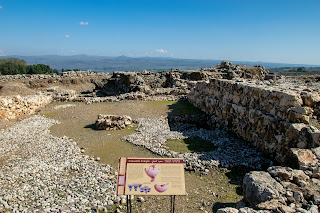Mount Tabor is a beautiful, iconic mountain in the Jezreel Valley, best known biblically as the location for 'Deborah's battle'.
In Judges 4, Deborah, a judge of Israel, told Barak to take 10,000 men to fight the armies of Hazor. (Remember Hazor from 2 weeks ago)?
Like Hazor, Mount Tabor also sits on the ancient Via Maris, just farther south. It stood on the most important ancient trade route through the Land.
So, Deborah told Barak to go fight the armies of Hazor, and he didn't want to unless she went with him. She agreed, but said that because he was too afraid to lead alone, God would give the victory over to a woman. That woman was Yael, who drove a tent spike through the temple of Sisera, the general, when he entered her tent for a drink and a nap. The Bible says the spike went all the way into the ground! WOW!
Christian tradition also places Jesus, Peter, James, and John on this mountain in Matthew 17. They went up to pray and spend the evening, and Jesus was transfigured there—and Moses and Elijah appeared with him. This obviously isn't proven, since the mountain is unnamed in Scripture. Still, we know this really happened, and why not on Mount Tabor? After all, look at the view!
I spent Purim hiking around Mount Tabor in the Jezreel Valley, and am so excited to share about this incredible place today!
As with all locations where Catholic tradition places Jesus, there is a church at the top. Actually, there's two, a Catholic church and a Greek Orthodox one. When we were there, there was a tour group from Fiji who sang instead. I could hear it from the garden outside, and it was so beautiful!
There are 2 ways to get up to the church, drive up a switchback road with incredible views, or hike up 5k from the village below—almost straight up. We chose to drive and then walk the 2.5K trail around the summit. Because it was almost spring, there were flowers everywhere. We also saw caves along the trail—not to mention the stunning views!










































